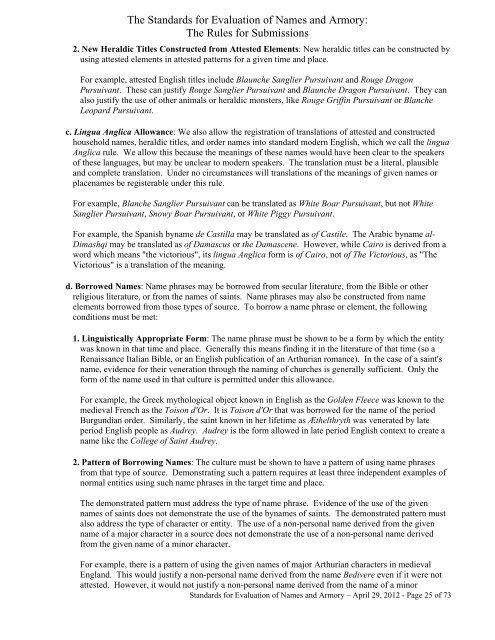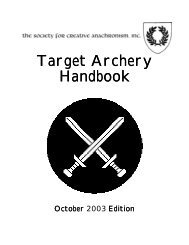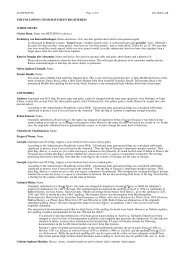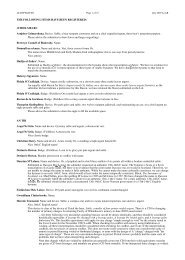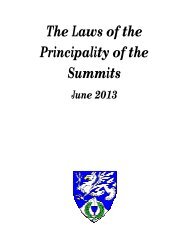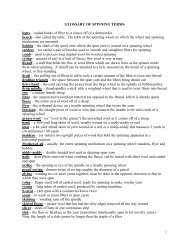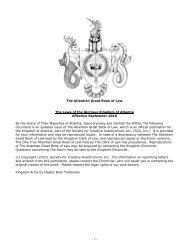The Standards for Evaluation of Names and Armory - SCA Heraldry
The Standards for Evaluation of Names and Armory - SCA Heraldry
The Standards for Evaluation of Names and Armory - SCA Heraldry
Create successful ePaper yourself
Turn your PDF publications into a flip-book with our unique Google optimized e-Paper software.
<strong>The</strong> <strong>St<strong>and</strong>ards</strong> <strong>for</strong> <strong>Evaluation</strong> <strong>of</strong> <strong>Names</strong> <strong>and</strong> <strong>Armory</strong>:<strong>The</strong> Rules <strong>for</strong> Submissions2. New Heraldic Titles Constructed from Attested Elements: New heraldic titles can be constructed byusing attested elements in attested patterns <strong>for</strong> a given time <strong>and</strong> place.For example, attested English titles include Blaunche Sanglier Pursuivant <strong>and</strong> Rouge DragonPursuivant. <strong>The</strong>se can justify Rouge Sanglier Pursuivant <strong>and</strong> Blaunche Dragon Pursuivant. <strong>The</strong>y canalso justify the use <strong>of</strong> other animals or heraldic monsters, like Rouge Griffin Pursuivant or BlancheLeopard Pursuivant.c. Lingua Anglica Allowance: We also allow the registration <strong>of</strong> translations <strong>of</strong> attested <strong>and</strong> constructedhousehold names, heraldic titles, <strong>and</strong> order names into st<strong>and</strong>ard modern English, which we call the linguaAnglica rule. We allow this because the meanings <strong>of</strong> these names would have been clear to the speakers<strong>of</strong> these languages, but may be unclear to modern speakers. <strong>The</strong> translation must be a literal, plausible<strong>and</strong> complete translation. Under no circumstances will translations <strong>of</strong> the meanings <strong>of</strong> given names orplacenames be registerable under this rule.For example, Blanche Sanglier Pursuivant can be translated as White Boar Pursuivant, but not WhiteSanglier Pursuivant, Snowy Boar Pursuivant, or White Piggy Pursuivant.For example, the Spanish byname de Castilla may be translated as <strong>of</strong> Castile. <strong>The</strong> Arabic byname al-Dimashqi may be translated as <strong>of</strong> Damascus or the Damascene. However, while Cairo is derived from aword which means "the victorious", its lingua Anglica <strong>for</strong>m is <strong>of</strong> Cairo, not <strong>of</strong> <strong>The</strong> Victorious, as "<strong>The</strong>Victorious" is a translation <strong>of</strong> the meaning.d. Borrowed <strong>Names</strong>: Name phrases may be borrowed from secular literature, from the Bible or otherreligious literature, or from the names <strong>of</strong> saints. Name phrases may also be constructed from nameelements borrowed from those types <strong>of</strong> source. To borrow a name phrase or element, the followingconditions must be met:1. Linguistically Appropriate Form: <strong>The</strong> name phrase must be shown to be a <strong>for</strong>m by which the entitywas known in that time <strong>and</strong> place. Generally this means finding it in the literature <strong>of</strong> that time (so aRenaissance Italian Bible, or an English publication <strong>of</strong> an Arthurian romance). In the case <strong>of</strong> a saint'sname, evidence <strong>for</strong> their veneration through the naming <strong>of</strong> churches is generally sufficient. Only the<strong>for</strong>m <strong>of</strong> the name used in that culture is permitted under this allowance.For example, the Greek mythological object known in English as the Golden Fleece was known to themedieval French as the Toison d'Or. It is Toison d'Or that was borrowed <strong>for</strong> the name <strong>of</strong> the periodBurgundian order. Similarly, the saint known in her lifetime as Æthelthryth was venerated by lateperiod English people as Audrey. Audrey is the <strong>for</strong>m allowed in late period English context to create aname like the College <strong>of</strong> Saint Audrey.2. Pattern <strong>of</strong> Borrowing <strong>Names</strong>: <strong>The</strong> culture must be shown to have a pattern <strong>of</strong> using name phrasesfrom that type <strong>of</strong> source. Demonstrating such a pattern requires at least three independent examples <strong>of</strong>normal entities using such name phrases in the target time <strong>and</strong> place.<strong>The</strong> demonstrated pattern must address the type <strong>of</strong> name phrase. Evidence <strong>of</strong> the use <strong>of</strong> the givennames <strong>of</strong> saints does not demonstrate the use <strong>of</strong> the bynames <strong>of</strong> saints. <strong>The</strong> demonstrated pattern mustalso address the type <strong>of</strong> character or entity. <strong>The</strong> use <strong>of</strong> a non-personal name derived from the givenname <strong>of</strong> a major character in a source does not demonstrate the use <strong>of</strong> a non-personal name derivedfrom the given name <strong>of</strong> a minor character.For example, there is a pattern <strong>of</strong> using the given names <strong>of</strong> major Arthurian characters in medievalEngl<strong>and</strong>. This would justify a non-personal name derived from the name Bedivere even if it were notattested. However, it would not justify a non-personal name derived from the name <strong>of</strong> a minor<strong>St<strong>and</strong>ards</strong> <strong>for</strong> <strong>Evaluation</strong> <strong>of</strong> <strong>Names</strong> <strong>and</strong> <strong>Armory</strong> – April 29, 2012 - Page 25 <strong>of</strong> 73


